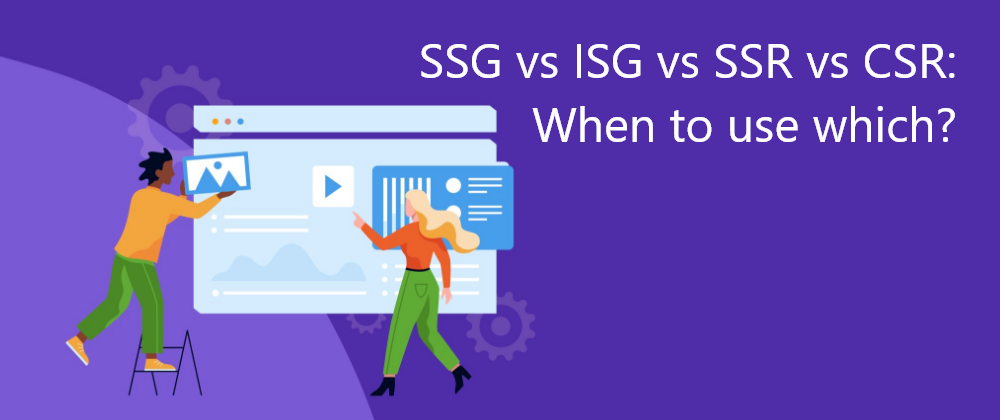So many jargons 😱! Let's not overload and fry our brains and check them out one by one.
1. Static Site Generation (SSG)
A static site generation is the process of generating a full static HTML website based on raw data and a set of templates. Essentially, a static site generation automates the task of coding individual HTML pages and gets those pages ready to serve to users ahead of time.
In simple terms, SSG pre-renders all the pages of your website and serves them as per the client's requests.
Pros
- A static site generator provides the ability to generate a completely static HTML-based site that requires little to no database or server-side processes.
- Static sites are the fastest form of web pages as they are pre-baked and ready to be served to users.
- Since the website is pre-baked, the content is much more secure.
- Search Engine Optimization (SEO) friendly.
Cons
- Content editing and publishing are difficult. Editors may require access to the
Gitrepository rather than a simple web app interface. - Content updates require the site to be rebuilt, tested, and finally deployed.
- Maintaining large websites becomes cumbersome, not to mention the huge build time.
When to use SSG?
Even though SSG has a lot of benefits, you should use it only when you have a website where the content rarely changes, like a product showcase website.
If you have a blog, you may use SSG, if you are okay with redeploying the site every time you make any modification.
For a site with any form of dynamic content, SSG is a strict no-no.
2. Server-Side Rendering (SSR)
Server-side rendering (SSR), is the ability of an application to generate the web page on the server instead of only rendering it in the browser. Server-side sends a fully rendered page to the client; the client's JavaScript bundle takes over and allows the
SPAframework to operate.
In SSR, since the page is rendered on the server and sent to the client, it opens up the possibility of using dynamic data and still having great SEO.
Pros
- Can be used to create pages with dynamic content.
- Though not as fast as SSG, SSR has fast perceived performance, as the visible content appears as soon as the page is loaded.
- Search Engine Optimization (SEO) friendly.
Cons
- SSR requires high computational power on the server as every request is processed on the server.
- SSR sites are harder to keep secure because they have a bigger surface to attack.
-
Cachingrequires a lot of complex configurations.
When to use SSR?
Since SSR has the potential to significantly drive up the server cost, it should be used sparingly, only when you have a site with highly dynamic content that changes very frequently and heavily relies on SEO. One such example might be a stock ticker website that gathers users from organic searches.
3. Incremental Static Regeneration (ISG)
Incremental Static Regeneration (ISR) enables you to use static-generation on a per-page basis, without needing to rebuild the entire site. With ISR, you can retain the benefits of static sites while scaling to millions of pages.
ISR is incredibly powerful because it brings the benefits of SSG and SSR together and creates a more efficient and scalable solution.
Pros
- Just like SSG, ISR is extremely fast, due to pre-rendering the pages and caching them.
- Content modification does NOT require re-deployment of the site.
- Search Engine Optimization (SEO) friendly.
Cons
- There is one huge drawback to ISR, users might end up viewing stale content if they visit the site after the content has been modified, but the new version of the site is not yet available.
When to use ISR?
Ideally, ISR should be used when you have a site where the content is dynamic but does NOT change frequently. A few examples of such sites would be blogs or personal websites.
My personal website too is made using ISR, to ensure updating the website I need to only update the data in the database.
4. Client-Side Rendering (CSR)
Client-side rendering (CSR) means rendering pages directly in the browser using JavaScript. All logic, data fetching, templating, and routing are handled on the client rather than the server.
In CSR, the server returns a blank HTML page and a JavaScript bundle that handles all logic.
Pros
- Can be used to create pages with dynamic content.
- Does NOT drive up the server cost, unlike SSG.
- After the initial load, loading other pages are very fast.
Cons
- Doesn't work well for SEO.
- Slow initial load time & time to become interactive, causing poor performance.
When to use CSR?
CSR is ideal for any site which does NOT rely heavily on SEO. It can be used to create rich site interactions and web & even cross-platform applications using tools like Tauri or Electron.
Wrapping Up
The rendering method totally depends on the requirements and the UX plan of the project. The final call is yours to make.
You don't even have to stick to only one method for an entire website, different methods can be used for different pages, eg: SSG for about and home pages, ISR for faq pages, and CSR for the actual web application.
I hope this article helped you to understand the basic concepts of rendering practice.
Happy Developing!
Finding personal finance too intimidating? Checkout my Instagram to become a Dollar Ninja
Thanks for reading
Need a Top Rated Front-End Development Freelancer to chop away your development woes? Contact me on Upwork
Want to see what I am working on? Check out my Personal Website and GitHub
Want to connect? Reach out to me on LinkedIn
I am a freelancer who will start off as a Digital Nomad in mid-2022. Want to catch the journey? Follow me on Instagram
Follow my blogs for Weekly new Tidbits on Dev
FAQ
These are a few commonly asked questions I get. So, I hope this FAQ section solves your issues.
-
I am a beginner, how should I learn Front-End Web Dev?
Look into the following articles:










Latest comments (1)
SSG is not the fastest, it would be a server-less solution running on the edge server (see Cloudflare Pages) or SSG stored in RAM (a bit faster than SSD storage); you can also render pages on the server and store it in RAM (eg. Redis KV)...